- Benefits of Whitewashing Trees
- 1. Protection from sunburn
- 2. Prevention of insect infestation
- 3. Protection against winter damage
- 4. Visual enhancement
- 5. Easy monitoring of pests and diseases
- 6. Minimization of herbicide and pesticide use
- Protection against sunburn
- Prevention of insect infestation
- Reduction of moisture loss
- Preservation of tree bark
- Benefits of whitewashing tree bark:
- Drawbacks of whitewashing tree bark:
- Myths about Whitewashing Trees
- Whitewashing damages tree health
- Whitewashing is unnecessary in all climates
- Whitewashing only has aesthetic benefits
- Protection against environmental factors
- Insect and disease prevention
- Additional benefits
- Understanding the Real Importance of Whitewashing Trees
- Protection from Sunburn
- Prevention of Insect Infestations
- Protection from Frost and Cold Temperatures
- Visual Signaling and Safety
- Conclusion
- Question-answer:
- Should I whitewash my trees?
- What is the purpose of whitewashing trees?
- Can whitewashing trees prevent frost damage?
- Are there any alternatives to whitewashing trees?
- Does whitewashing trees harm the environment?
- How often should I whitewash my trees?
- Can I use regular paint instead of whitewash for trees?
- Video: Why and How to Whitewash Your Fruit Trees || Black Gumbo
In recent years, there has been a growing debate over the practice of whitewashing trees. Some argue that it is necessary to protect trees from various threats, while others claim that it is unnecessary and potentially harmful. In order to understand the real importance of whitewashing, it is essential to separate fact from fiction and debunk the myths surrounding this controversial topic.
One common myth is that whitewashing trees is purely an aesthetic practice. While it is true that whitewashing can improve the appearance of trees, its benefits go beyond mere aesthetics. One of the main reasons for whitewashing is to protect trees from sunscald, a condition that occurs when the tree’s bark heats up during the day and then rapidly cools down at night. This rapid temperature change can cause the bark to crack and split, leaving the tree vulnerable to disease and pests.
Another myth is that whitewashing is harmful to the environment. Some critics argue that the chemicals used in the whitewashing process can have negative effects on the surrounding ecosystem. However, when done correctly, whitewashing is a safe and effective method of tree protection. Modern whitewashing formulas are typically non-toxic and biodegradable, ensuring minimal impact on the environment.
Furthermore, whitewashing can also act as a deterrent for insects and pests. Many insects are attracted to the dark color of tree bark, which serves as a camouflage for them. By applying a bright, reflective whitewash, the insects are less likely to land and infest the tree. This can help prevent the spread of destructive pests and diseases, ultimately promoting the overall health and longevity of the tree.
Despite the myths and controversies surrounding whitewashing, it is clear that this practice serves an important purpose in protecting trees from sunscald, pests, and diseases. By understanding the real importance of whitewashing and debunking the myths, we can make informed decisions about how to best care for our trees and ensure their long-term health and vitality.
Benefits of Whitewashing Trees
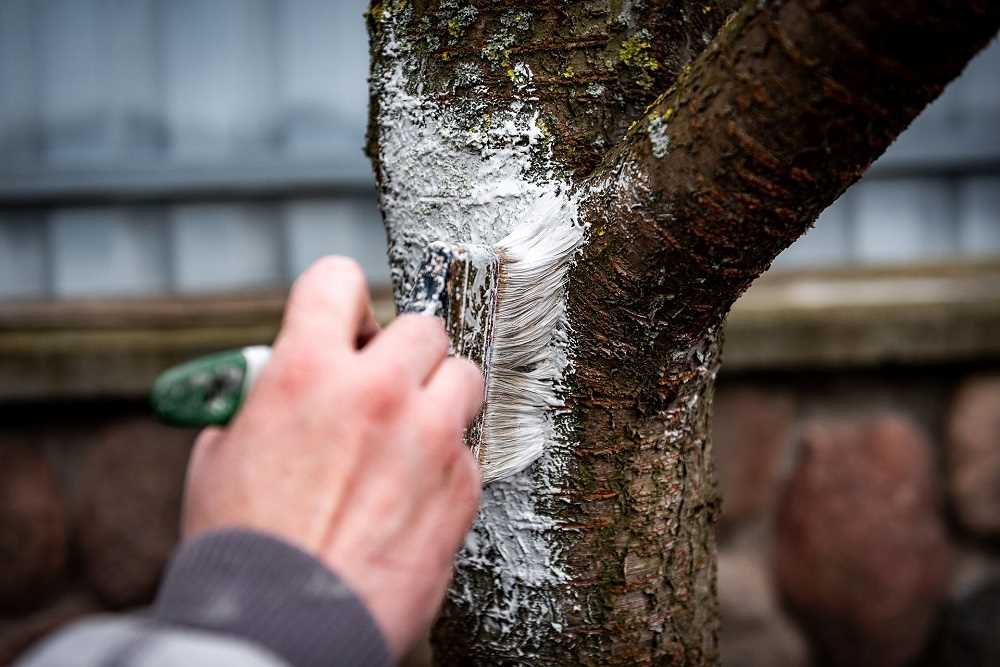
Whitewashing trees has been a common practice for many years, and it offers a number of benefits that can help improve the overall health and appearance of trees. Here are some of the main benefits of whitewashing trees:
1. Protection from sunburn
Whitewashing trees can provide protection against sunburn, which occurs when the direct sunlight heats up the tree bark to a level that causes damage. The white color reflects sunlight, reducing heat absorption and preventing the bark from reaching harmful temperatures. This is especially important for young or newly planted trees with thin bark.
2. Prevention of insect infestation
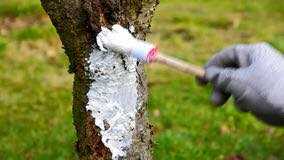
Whitewashing trees can act as a deterrent for certain insects, including borers and other pests that are attracted to dark-colored tree bark. The white color disrupts their visual cues and makes it harder for them to locate and infest the tree. This can help prevent damage caused by insect feeding or egg-laying.
3. Protection against winter damage
During winter months, whitewashing trees can protect them from cold temperatures and frost. The white coating reflects sunlight, helping to keep the tree warmer and reducing the likelihood of frost damage. Additionally, it can prevent temperature fluctuations that can lead to bark splitting and other cold-related issues.
4. Visual enhancement
Whitewashing trees can improve the overall appearance of the landscape. The bright white color can make the trees stand out and create a visually appealing contrast against green foliage or surrounding structures. This aesthetic enhancement can add value and beauty to any outdoor space.
5. Easy monitoring of pests and diseases
When trees are whitewashed, any signs of pests or diseases are more easily visible on the bright white surface. This makes it easier for homeowners, arborists, or gardeners to detect early symptoms of infestations or diseases and take appropriate action. Regular inspections can be conducted more efficiently, leading to prompt treatment and prevention of further damage.
6. Minimization of herbicide and pesticide use
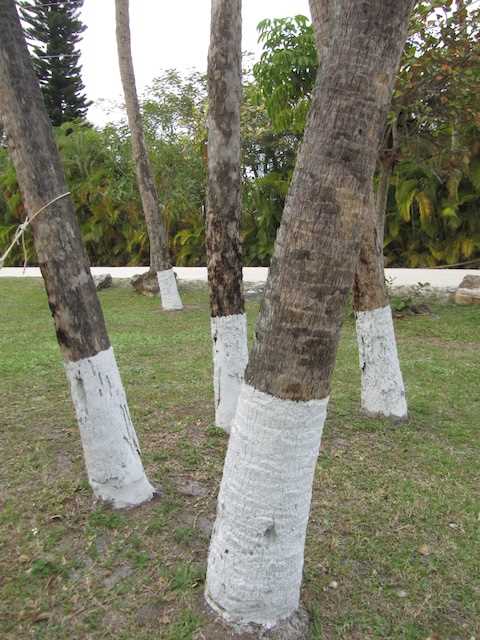
Whitewashing trees can decrease the need for herbicide and pesticide applications. By acting as a physical barrier, the white coating can help prevent weeds from growing around the tree base and reduce the number of insects that may require chemical control. This promotes a more environmentally friendly approach to tree care.
Overall, whitewashing trees offers numerous benefits that contribute to their health, protection, and aesthetic appeal. It is a simple and cost-effective technique that can be utilized to enhance the well-being of trees in various settings.
Protection against sunburn
One of the main reasons trees are whitewashed is to protect them from sunburn. Sunburn occurs when a tree’s bark becomes overheated as a result of prolonged exposure to direct sunlight. This can happen on hot summer days or in climates with high levels of sunlight.
Sunburn can cause significant damage to a tree. It can lead to blistering, cracking, and peeling of the bark, which creates an entry point for pests and diseases. In severe cases, sunburn can even kill a tree.
Whitewashing the trunks of trees can help protect them from sunburn. The white color reflects sunlight and reduces the amount of heat absorbed by the bark. This helps to keep the temperature of the bark lower and prevents it from overheating.
In addition to reflecting sunlight, the white paste or paint used for whitewashing also acts as a physical barrier, protecting the bark from direct exposure to the sun’s rays. This can further reduce the risk of sunburn and the resulting damage to the tree.
It’s important to note that not all trees require whitewashing for sunburn protection. Some tree species have naturally thick or reflective bark that provides adequate protection. Additionally, trees in shaded areas or those surrounded by other vegetation may not experience as much direct sunlight and therefore may not require whitewashing.
Overall, whitewashing is an effective and relatively inexpensive method to protect trees from sunburn. It helps to maintain the health and vitality of the trees, ensuring their longevity and ability to provide environmental benefits such as shade, oxygen production, and carbon dioxide absorption.
Prevention of insect infestation
- Regular pruning: Pruning trees regularly helps to remove dead or decaying wood, which can attract insects. By removing these vulnerable areas, you can prevent insects from infesting the tree.
- Proper tree maintenance: Proper tree maintenance, such as watering, fertilizing, and mulching, can help keep trees healthy and strong. Healthy trees are less likely to be targeted by insects, as they are more resistant to infestation.
- Monitoring: Regularly inspecting trees for signs of insect infestation is crucial in preventing further damage. Look for visible signs such as holes in the bark, sawdust-like frass, or insect activity on the tree.
- Use of insect-repellent sprays: Applying insect-repellent sprays can provide an additional layer of protection against insects. However, it is important to choose the appropriate spray for the specific insect and follow the instructions carefully.
- Biological control: Introducing natural enemies of insects, such as predators or parasites, can help control insect populations. This can be done through the release of beneficial insects or by providing suitable habitats for them.
- Chemical treatments: In severe cases where other methods have failed, chemical treatments may be necessary. However, these should be used as a last resort, and it is important to follow the recommended dosage and safety guidelines.
Reduction of moisture loss
One of the main benefits of whitewashing trees is the reduction of moisture loss. When the trunk and branches of a tree are exposed to direct sunlight, they can lose a significant amount of water through evaporation. This water loss can be detrimental to the health and vitality of the tree, especially during hot and dry periods.
The white paint used in the whitewashing process acts as a reflective barrier, reducing the amount of sunlight that reaches the tree’s surface. By reflecting the sunlight away from the tree, whitewashing helps to lower the temperature of the trunk and branches, thereby decreasing the rate of evaporation.
Additionally, the white paint also helps to seal the pores on the tree’s bark, preventing excessive water loss through transpiration. Transpiration is the process by which trees release water vapor from their leaves. By sealing the bark, whitewashing further aids in reducing moisture loss and allows the tree to retain more water for vital functions.
Overall, by reducing moisture loss, whitewashing helps to maintain the tree’s hydration levels and promote its overall health and well-being during periods of drought or intense heat.
Preservation of tree bark
- The bark of a tree is an important part of its structure and plays a crucial role in its overall health and well-being.
- Tree bark acts as a protective barrier, shielding the tree from harmful elements such as extreme temperatures, pests, diseases, and mechanical damage.
- Preserving the bark is essential to ensure the longevity and vitality of a tree.
- One way to preserve tree bark is by avoiding activities that can damage or remove it, such as careless pruning, excessive abrasion from machinery, or unintentional impact.
- Another method of preserving tree bark is by providing proper care and maintenance, including regular watering, mulching, and fertilization, to keep the tree healthy and strong.
- In some cases, applying a protective coating or paint to the tree bark can help prevent damage from harsh weather conditions or pests.
It is important to note that the use of whitewash or other tree paints can have both benefits and drawbacks in terms of bark preservation.
Benefits of whitewashing tree bark:
- Whitewashing can act as a sunblock, preventing excessive heat absorption by the bark, which can help protect the tree from sunscald and heat stress.
- It can also help repel insects and prevent infestations, as certain paints contain chemicals that are toxic to pests.
- Whitewashing can conceal and protect wounds or damaged areas on the bark, allowing them to heal without further harm.
Drawbacks of whitewashing tree bark:
- Some types of whitewash or tree paint can inhibit the tree’s natural breathing process by sealing the bark, which can lead to moisture retention and fungal growth.
- Improper application of whitewash can result in an uneven or thick coating, which may interfere with the tree’s ability to exchange gases and absorb sunlight necessary for photosynthesis.
- If the whitewash contains harmful chemicals or toxins, it can have negative effects on the tree, the surrounding environment, and human health.
Therefore, when considering whether to whitewash or not to whitewash tree bark, it is essential to weigh the benefits against the drawbacks and consider the specific needs of the tree and its environment.
Myths about Whitewashing Trees
Whitewashing trees has been a common practice for many years, but there are several myths surrounding this technique that need to be debunked. Let’s take a closer look at some of the most common myths about whitewashing trees:
Myth 1: Whitewashing trees is only done for aesthetic purposes.
While it is true that whitewashing trees can improve their appearance, this is not the sole purpose of the technique. Whitewashing provides a protective coating that helps to prevent sunscald, which can occur when the sun warms the bark during the day and then rapidly cools at night, causing damage to the tree.
Myth 2: Only certain types of trees benefit from whitewashing.
Whitewashing can benefit a wide variety of trees. While some tree species may be more prone to sunscald, all trees can benefit from the protective barrier that whitewashing provides. Additionally, whitewashing can also deter pests and reduce the risk of disease.
Myth 3: Whitewashing is a difficult and time-consuming process.
Contrary to popular belief, whitewashing trees is a relatively simple and quick process. It involves mixing lime or white latex paint with water to create a paste-like consistency, which is then applied evenly to the trunk and branches of the tree. This process can be completed in just a few hours, depending on the size of the tree.
Myth 4: Whitewashing is harmful to trees and the environment.
Some people believe that the chemicals used in whitewashing can be harmful to trees and the environment. However, this is not the case when using lime or white latex paint, which are non-toxic and safe for trees. In fact, whitewashing can actually extend the lifespan of trees by protecting them from various forms of damage.
By debunking these myths, it becomes clear that whitewashing trees is a beneficial practice that helps to protect and preserve their health and longevity. Whether it’s preventing sunscald, deterring pests, or reducing the risk of disease, whitewashing can play a vital role in maintaining the well-being of trees.
Whitewashing damages tree health

Contrary to popular belief, whitewashing can actually be detrimental to the health of trees. While it may seem like a protective measure, it can cause more harm than good in the long run.
One of the main reasons whitewashing damages tree health is that it can trap moisture against the trunk. When whitewash is applied too thickly or is not allowed to dry properly, it can create a barrier that prevents moisture from evaporating. This trapped moisture can lead to the growth of fungi and bacteria, which can cause diseases to develop on the tree.
Furthermore, whitewashing can also interfere with the tree’s natural process of transpiration. Transpiration is the process by which trees release water vapor through their leaves, helping to cool themselves and maintain their internal moisture balance. When a tree is whitewashed, this process can be disrupted, leading to an imbalance in moisture levels and potentially causing stress to the tree.
Additionally, the chemicals present in some whitewash products can be toxic to trees. These chemicals can have negative effects on the tree’s cellular structure and overall health. It is important to use natural and non-toxic alternatives if whitewashing is deemed necessary.
It is worth noting that many trees have evolved natural protection mechanisms, such as bark, to defend against various environmental threats. The natural processes of bark shedding and regeneration can be hindered by the application of whitewash, further compromising the tree’s health.
In conclusion, it is best to avoid whitewashing trees as it can cause more harm than good. Instead, focus on maintaining overall tree health through proper pruning, watering, and regular inspections for signs of pests or diseases.
Whitewashing is unnecessary in all climates
There is a common misconception that whitewashing trees is necessary in all climates. However, this is not true. Whitewashing is a practice that involves applying a white solution or paint to the trunks and branches of trees. It is often believed that this practice helps protect trees from various environmental factors, such as extreme temperatures, insects, and diseases.
While it is true that whitewashing can provide some benefits in certain situations, it is not necessary in all climates. The effectiveness of whitewashing largely depends on the specific environmental conditions and the type of tree. In some climates, the natural defenses of trees are already sufficient to protect them from potential harm.
One of the main reasons why whitewashing is unnecessary in all climates is because trees have their own ways of adapting to their environments. For example, the bark of many tree species is naturally resilient and can protect the tree from extreme temperatures and insect attacks. Additionally, trees can produce their own natural substances, such as resins and oils, which act as protective barriers against pests and diseases.
Furthermore, whitewashing can have negative consequences if not done properly. The application of the whitewash solution can create a moisture barrier, preventing the tree from transpiring effectively. This can lead to a buildup of excess moisture, which can promote the growth of fungi and other pathogens. Additionally, if the whitewash solution contains harmful chemicals, it can have detrimental effects on the tree and the surrounding environment.
Instead of relying solely on whitewashing, it is more important to focus on overall tree health and proper maintenance. This includes providing adequate water, nutrients, and sunlight, as well as monitoring for any signs of pests or diseases. Regular pruning and trimming can also help promote tree health and prevent the spread of diseases.
In conclusion, whitewashing is unnecessary in all climates. While it may provide some benefits in certain situations, trees have their own natural defenses and ways of adapting to their environments. Proper tree maintenance and care should be prioritized instead of relying solely on whitewashing as a protective measure.
Whitewashing only has aesthetic benefits
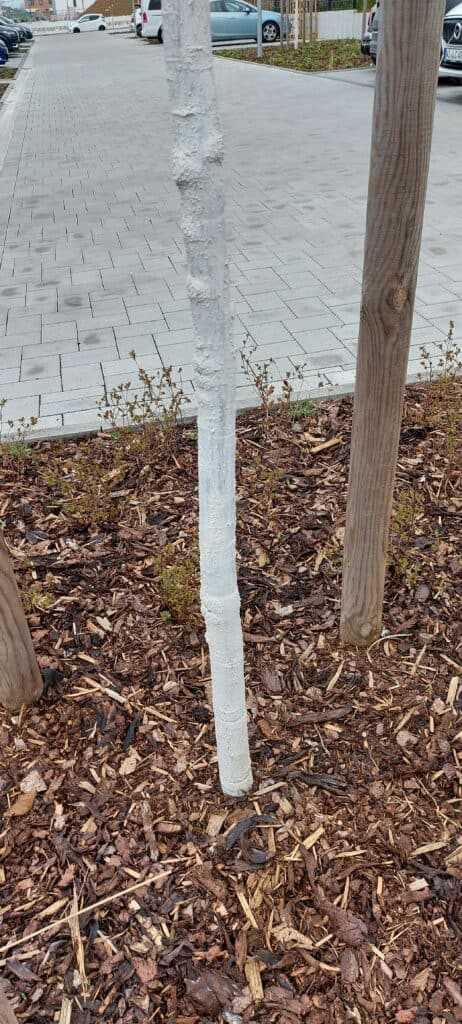
One common misconception about whitewashing trees is that it is only done for aesthetic purposes. While it is true that whitewashing can improve the appearance of trees, its benefits go beyond just aesthetics.
Protection against environmental factors
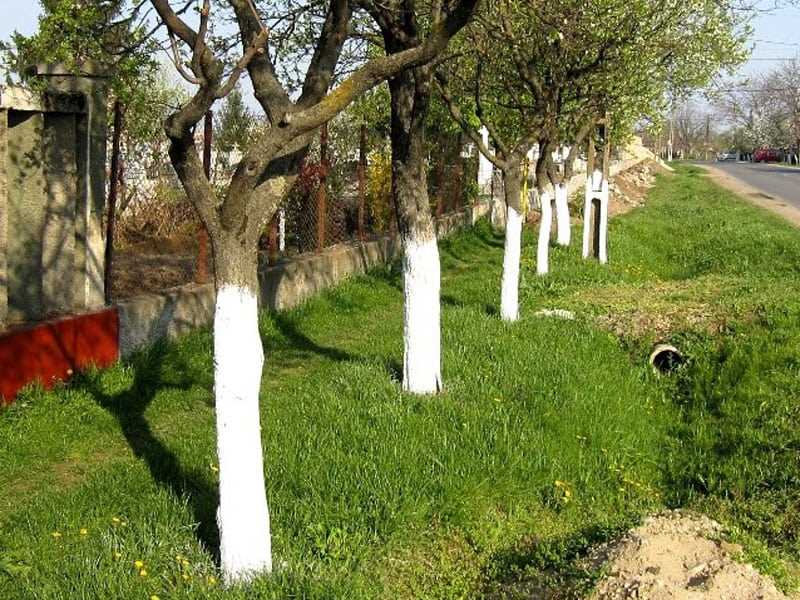
Whitewashing can help protect trees from various environmental factors. The white paint or mixture used for whitewashing acts as a barrier, shielding the tree bark from damage caused by sunlight, extreme temperatures, and wind. By reflecting sunlight, whitewashing prevents the tree bark from overheating, which can lead to sunscald. It also helps to keep the temperature of the bark more stable, reducing the risk of freeze-thaw cycles that can damage the tree.
Insect and disease prevention
Another benefit of whitewashing is its ability to prevent insect infestation and the spread of diseases. Insects are less likely to lay eggs on white surfaces, making whitewashed trees less attractive to pests. Additionally, the reflective nature of the white paint can deter insects from landing on the tree bark. The whitewash also creates a physical barrier that can prevent some insects from burrowing into the tree. As for diseases, the white paint can make it easier to spot signs of infection or decay, allowing for prompt treatment before it spreads further.
Additional benefits
Whitewashing can also have practical benefits for both young and newly planted trees. The white color increases visibility, making it easier for motorists to spot the trees and avoid collisions. It can also act as a repellent for grazing animals, keeping them away from the tree bark.
While the aesthetics of whitewashing are often appreciated, it is important to recognize that the practice serves a more significant purpose. By protecting trees from environmental factors, preventing insect infestations and diseases, and providing visibility and repellent properties, whitewashing plays a vital role in maintaining the health and longevity of trees.
Understanding the Real Importance of Whitewashing Trees
Whitewashing trees is a practice that involves applying a white paint or diluted lime solution on the trunks and branches of trees. While some may argue that whitewashing is purely aesthetic, it serves several important purposes for the health and wellbeing of trees.
Protection from Sunburn
One of the main reasons to whitewash trees is to protect them from sunburn. The intense heat of the sun can cause the bark of trees to crack and split, leaving them vulnerable to pests and diseases. By applying a layer of white paint or lime solution, the reflected sunlight helps to keep the temperature of the bark lower, preventing sunburn and reducing the risk of damage.
Prevention of Insect Infestations
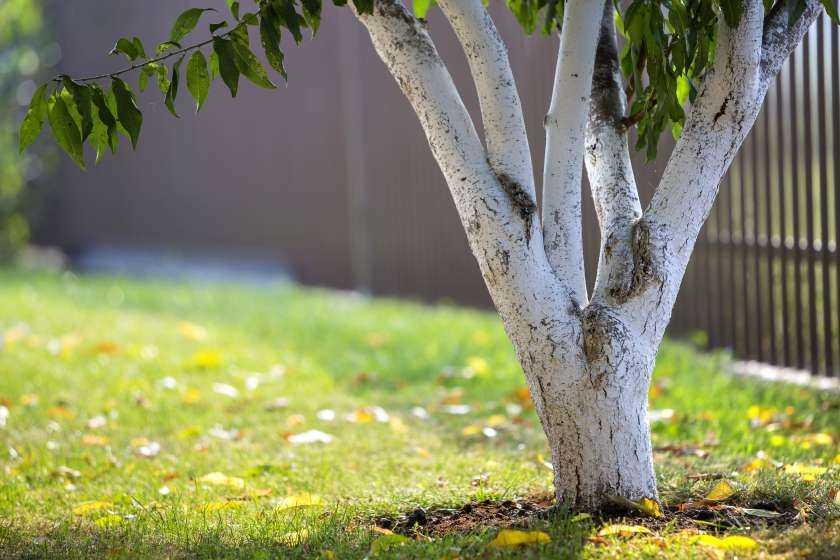
Whitewashing trees also helps to deter insect infestations. Many insects are attracted to the dark color of tree bark, as it provides a suitable hiding place for them. By painting the trunks and branches with a bright, white color, it becomes less attractive to insects, reducing the likelihood of them colonizing the tree.
Protection from Frost and Cold Temperatures
In regions with cold winters, whitewashing trees can provide protection against frost and freezing temperatures. The white paint or lime solution acts as an insulating layer, helping to retain heat and preventing the bark from freezing. This is particularly important for young or newly planted trees that might be more susceptible to cold damage.
Visual Signaling and Safety
Whitewashing trees can also serve as a visual signal to mark trees that may need special attention or care. It can act as a reminder for gardeners or arborists to check on the health of the tree or perform necessary maintenance, such as pruning or fertilizing. Additionally, when whitewashed trees are near roads or paths, it helps increase visibility and prevent accidental collisions, especially during low-light conditions.
Conclusion
While some may view whitewashing trees as purely cosmetic, it serves important purposes in protecting trees from sunburn, insect infestations, frost, and cold temperatures. Additionally, it can act as a visual signal and improve safety. By understanding the real importance of whitewashing, we can ensure the health and longevity of our trees.
Question-answer:
Should I whitewash my trees?
Whitewashing trees can be beneficial in certain situations. It helps protect the tree bark from extreme temperatures, sunburn, and pests. However, it is not always necessary and depends on the specific tree species, location, and climate. Consulting with an arborist can help determine if whitewashing is necessary for your trees.
What is the purpose of whitewashing trees?
The main purpose of whitewashing trees is to protect them from various environmental factors. The whitewash forms a barrier that reflects sunlight and prevents the bark from becoming too hot, thereby reducing the risk of sunburn. It also acts as a deterrent for pests, such as insects and rodents, that may otherwise damage the trees.
Can whitewashing trees prevent frost damage?
Whitewashing trees can provide some protection against frost damage. The white coating reflects sunlight and helps keep the tree bark colder, reducing the chances of frost damage. However, it is important to note that whitewashing alone may not provide sufficient protection during severe frost events. Additional measures, such as covering the trees with frost blankets, may be necessary in extreme cases.
Are there any alternatives to whitewashing trees?
Yes, there are alternatives to whitewashing trees. One alternative is using tree wraps or tree guards, which are made of breathable materials and offer similar protection against sunburn and pests. Additionally, planting trees in locations with natural shade or providing artificial shade through structures like umbrellas or pergolas can also help protect the trees from excessive sun exposure.
Does whitewashing trees harm the environment?
Whitewashing trees itself does not harm the environment. However, the type of whitewash and the method of application can have environmental impacts. It is important to use environmentally friendly, non-toxic whitewash products and apply them according to the manufacturer’s instructions. Avoid excessive use of whitewash, as it may affect the natural processes of the tree and nearby ecosystems.
How often should I whitewash my trees?
The frequency of whitewashing trees depends on various factors such as climate, tree species, and the condition of the existing whitewash. In general, it is recommended to apply whitewash every 2-3 years or whenever the existing whitewash starts to wear off or fade. Regular inspection of the trees and consulting with an arborist can help determine the appropriate timing for whitewashing.
Can I use regular paint instead of whitewash for trees?
No, it is not recommended to use regular paint instead of whitewash for trees. Regular paint can prevent the tree bark from breathing, leading to moisture retention and potential fungal growth. Whitewash, on the other hand, is specifically formulated for trees and allows the bark to breathe while providing the necessary protection. It is important to use products specifically designed for tree whitewashing.







